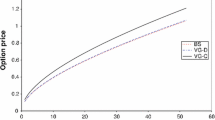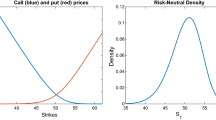Abstract
By applying the option pricing theory ideas, this paper models the estimation of firm value distribution function as an entropy optimization problem, subject to correlation constraints. It is shown that the problem can be converted to a dual of a computationally attractive primal geometric programming (GP) problem and easily solved using publicly available software. A numerical example involving stock price data from a Japanese company demonstrates the practical value of the GP approach. Noting the use of Monte Carlo simulation in option pricing and risk analysis and its difficulties in handling distribution functions subject to correlations, the GP based method discussed here may have some computational advantages in wider areas of computational finance in addition to the application discussed here.
Similar content being viewed by others
References
F. Black and M. Scholes, Pricing of options and corporate liabilities, Journal of Political Economy 81 (1973) 637–659.
P.P. Boyle, Options: A Monte Carlo approach, Journal of Financial Economics 4 (1977) 323–328.
P.W. Buchen and M. Kelly, The maximum entropy distribution of an asset inferred from option prices, Journal of Finance and Quantitative Analysis 31 (1996) 143–159.
A. Charnes, K.E. Haynes, F.Y. Phillips and G. White, New equivalences and dualities from the extremal solutions of the gravity models of spatial interaction; an approach using unconstrained dual of an extended geometric programming problem, Journal of Regional Sciences 17 (1977) 71–76.
J.M. Cozzolino and M.J. Zahner, The maximum entropy distribution of the future market price of a stock, Operations Research 21 (1973) 1200–1211.
P. Crosbie, Modeling default risk, in: Credit Derivatives-Trading & Management of Credit & Default Risk, ed. S. Das (Wiley, Singapore, 1998) pp. 299–315.
A. Damodaran, Investment Valuation-Tools and Techniques for Determining the Value of any Asset (Wiley, 1996).
R.J. Duffin, E.L. Peterson and C. Zener, Geometric Programming-Theory and Applications (Wiley, New York, 1967).
P. Embrechts, A. McNeil and D. Straumann, Correlation: Pitfalls and alternatives, RISK (1999) 69-71.
S.C. Fang, J.R. Rajasekera and H.S.J. Tsao, Entropy Optimization and Mathematical Programming (Kluwer Academic, 1997).
R. Geske, Valuation of compound options, Journal of Financial Economics 7 (1979) 63–81.
J.M. Harrison, Brownian Motion and Stochastic Flow Systems (Wiley, 1985).
J.C. Hull, Options, Futures, and Other Derivative Securities, 2nd ed. (Prentice-Hall, 1993).
J.C. Jackwerth and M. Rubinstein, Recovering probability distributions from option prices, The Journal of Finance 51(5) (1996) 1611–1631.
E.T. Jaynes, Information theory and statistical mechanics, Physics Review 106 (1957) 620–630.
T.R. Jefferson and C.H. Scott, Entropy and geometric programming in transportation planning, Opsearch 15 (1978) 22–34.
J.N. Kapur, Maximum Entropy Models in Science and Engineering (Wiley, New Delhi, India, 1989).
I.J. Myung, S. Ramamoorti and A.D. Bailey, Maximum entropy aggregation of expert predictions, Management Science 42(10) (1996) 1420–1436.
T.R. Rockafellar, Convex Analysis (Princeton University Press, 1972).
L. Schrage, Optimization Modeling with LINGO, LINDO Systems (January 1999).
M. Stutzer, A simple nonparametric approach to derivative security valuation, Journal of Finance 51 (1996) 1633–1652.
M. Stutzer and M. Chowdhury, A simple nonparametric approach to bond futures option pricing, Journal of Fixed Income 8 (1999) 67–76.
M. Yamada and J.R. Rajasekera, Business activities evaluation analysis, Nikkei Financial (April 28, 1999) (in Japanese).
Author information
Authors and Affiliations
Rights and permissions
About this article
Cite this article
Rajasekera, J., Yamada, M. Estimating the Firm Value Distribution Function by Entropy Optimization and Geometric Programming. Annals of Operations Research 105, 61–75 (2001). https://doi.org/10.1023/A:1013397314149
Issue Date:
DOI: https://doi.org/10.1023/A:1013397314149




